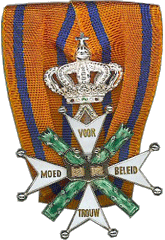 The Military Order of William is the oldest and, at the same time, highest honour of the Kingdom of the Netherlands. The honour was instituted by law, no. 5 of 30 April 1815. That act, comprised of 12 articles, was in force until 30 April 1940 when it was revised, while ‘retaining its proven sound basis’.
The Military Order of William is the oldest and, at the same time, highest honour of the Kingdom of the Netherlands. The honour was instituted by law, no. 5 of 30 April 1815. That act, comprised of 12 articles, was in force until 30 April 1940 when it was revised, while ‘retaining its proven sound basis’.
The first article now read as follows:
‘There is an Order, instituted to reward members of the armed forces in the service of the Kingdom of the Netherlands, who have distinguished themselves in battle by outstanding acts of bravery, skill and loyalty.
In special cases, non-military Dutch subjects and foreign nationals, who have distinguished themselves by such acts, may also be admitted into the order.’
The Military Order of William is comprised of four classes:
Knights of the First Class, or Grand Cross,
Knights of the Second Class, or Commanders,
Knights of the Third Class,
Knights of the Fourth Class.
The first person who had the honour of being admitted to the register of the Order was the Prince of Orange – later King William II – who had led Dutch troops in 1815 at Quatre Bras and Waterloo.
There were more than a thousand awards made following these two battles and there would be many more during the remainder of the nineteenth century. A large number of new knights, for instance, were admitted to the register after the Belgian Revolt in 1830 and the Ten Days’ Campaign a year later. The Netherlands-Indies was the main region where the Military Order of William could be earned. The problem area of Aceh ‘took the honours’, almost literally, in this respect. In the years between 1873 and 1927, the innumerable military actions that took place there led to a harvest of two Grand Crosses, six Commanders Crosses, 42 Knights of the Third Class Crosses and more than 800 Knights of the Fourth Class Crosses. Until 1940, a total of 5,874 persons had been awarded the Military Order of William.
Since 1940, 199 names have been added to the register of the Military Order of William. Among them were two members of the Royal family, Prince Bernhard, who was appointed Commander on 15 June 1946 , and Princess Wilhelmina, who was appointed to Knight of the First Class on 4 September 1948.
They received their awards in recognition of their inspiring leadership during the Second World War.
The princess was the first woman to be admitted to the register of the Order. Furthermore, six elements of the Netherlands armed forces were also decorated as a consequence of their actions during the Second World War:
the Naval Air Arm of the Royal Netherlands Navy;
the Marine Corps of the Royal Netherlands Navy;
the Submarine Service of the Royal Netherlands Navy;
the Royal Netherlands ‘Prinses Irene’ Brigade, whose traditions are continued by the ‘Prinses Irene’ Fusilier Guards Regiment;
the Military Air Arm in the Netherlands, whose traditions are continued by the Royal Netherlands Air Force;
the Military Air Arm of the Royal Netherlands Indies Army, whose traditions are continued by the Royal Netherlands Air Force.
Since 1972, the Military Order of William has been part of the colours of the ‘Van Heutsz’ Regiment of the Royal Netherlands Army. This regiment continues the traditions of the Royal Netherlands Indies Army (KNIL). Three KNIL units, namely the 7th Field Battalion, the Third Field Battalion and the Marechaussee Corps of Aceh and Dependencies were awarded the Order in 1849, 1877 and 1930 respectively.
The first foreign unit to be admitted to the Order was the 82nd (US) Airborne Division for its role in Operation Market Garden. The 1st Polish Independent Parachute Brigade, whose traditions are continued by the 6th Polish Air Assault Brigade, will now join the American division.
The last time that the Military Order of William was awarded to an individual was on 12 July 1955, to Captain J.H.C. Ulrici and Captain T.E. Spier. Captain Ulrici was awarded the honour for his role in the Dutch Resistance Army (1940-1945) and for his actions in Netherlands Indies as a serviceman.
Captain Spier received the honour on account of his actions in Netherlands-Indies. The awards ceremony took place in the Frederik Hendrik Barracks in Vught. The two officers received their medals from Prince Bernhard, who also gave them the traditional accolade.
The last conflict that was cause for the honour to be awarded was the war in Korea. Of the 3,500 servicemen who served in the Netherlands United Nations Detachment in Korea, three servicemen – two posthumously – were admitted to the Order.
